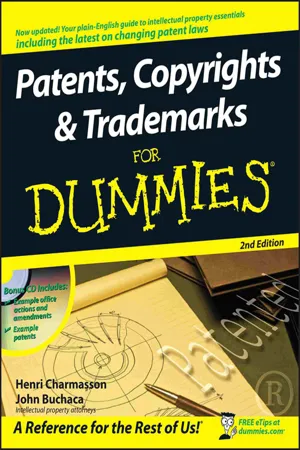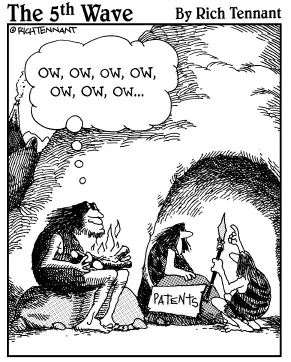Part I
Corralling Your IP Assets: Intellectual Property Basics
In this part . . .
If you’re reading this page, you probably have an invention, a creative work, a trademark, or some other piece of intellectual property that you want to guard against all the copycats out there. Well, you’ve come to the right place. In this part, we give you an overview of intellectual property (IP) in all its glory and tell you why protecting these assets is important. We map out each IP instrument — patents, copyrights, and commercial identifiers — showing how they each protect a different type of IP asset. We also talk about ways to treat your IP as a trade secret, by restricting access to information, using confidentiality agreements, and taking advantage of other tools at your disposal. And we discuss hiring an IP professional (when, why, and how), working effectively with an attorney or agent, and estimating how much the whole process can set you back.
Chapter 1
Marshalling Your IP Tools
In This Chapter
Understanding the difference between IP assets and IP rights
Perusing patents and what they can protect
Checking out copyrights and their applications
Taking a look at trademarks and related commercial names
Looking at trade secrets and their uses
Making money with your IP rights
Enforcing your IP rights in court
Welcome to the world of intellectual property — which is abbreviated IP. If you’ve created, invented, or named something that you’re selling, you already have intellectual property. And that property could be quite valuable. What if you’d invented the Segway scooter or written the first For Dummies book? Wouldn’t you like to be able to cash in on it? Exploiting your IP assets for your own financial gain and, at the same time, pursuing those who may infringe on your precious but fragile rights to those assets (called IP rights) is what this chapter and, in general, this book are all about.
Defining Intellectual Property
What is intellectual property? Although we’ve encountered many true and effective definitions — including information that has commercial value, a proprietary product of the mind, and things protected by patents, copyrights, and trademarks — none of them is quite complete. Here’s the one we like best:
Intellectual property is intangible creations of the mind that can be legally protected.
Because IP has no physical form, we can give you a better idea of what it is by providing examples of what it isn’t. Intellectual property is not
The new and wondrous machine that you developed in your garage, but the invention embodied in that machine.
The marvelously efficient cholesterol-reducing pill you see advertised on TV, but the formula and the process used in manufacturing that pill.
The physical portrait that an artist made of you, but the aesthetic expression of the artist’s talent reflected by the painting.
The riding mower you reluctantly start up every Saturday, but the brand name that embodies the reputation of the product and its manufacturer.
Now, if you’d be so kind as to refer back to our earlier, scintillating IP definition, we’d like to expand on it. Intellectual property is made up of two components: assets and rights.
Assets
IP assets are intangible creations, such as the invention, the formula and process, the expression of artist’s talents as reflected in a painting, and the brand name.
Rights
IP rights are the legal protections that secure each IP asset against its unauthorized use by others. One or more of the following legal protections can be used to secure IP rights:
Patents: Obtaining a patent protects the invention from outright thievery.
Trade secrets: Keeping a formula or manufacturing process confidential safeguards it against imitators.
Copyrights: Holding a copyright shields artistic expression against copying by others.
Trademarks: Adopting a trademark as a brand name keeps it and its market reputation yours and yours alone.
Contractual rights: Licensing the right to use someone else’s invention, for example, gives rights to the licensee while allowing the patent holder to profit from her invention through royalties.
Some IP rights — copyrights, trademark rights, and trade secrets in particular — attach themselves automatically upon the creation or use of the IP assets without your ever having to lift a finger or spend a cent. Obtaining other IP rights — patents, specifically — requires you to put up a pretty good fight and spend plenty of money.
What happens when you don’t protect your IP assets? Sorry, Charlie, but an unprotected IP asset is up for grabs — anyone can copy it, steal it, or change it for the worse (possibly damaging your good reputation). The bottom line is that your unprotected IP will fatten the bad guy’s bottom line.
But there’s more to IP assets and rights than mere talk of patents, copyrights, and trademarks, and that’s what this chapter is all about. First of all, you must verify that you in fact own that IP asset you want to protect, you have to make sure it’s original, and you must know how to secure all the IP rights that can apply to it. And last but not least, you have to know how to get the professional advice you need. Curtain, please.
Exploring the Patent Process
We may as well start with the most well-known (though not the most practical) form of IP protection: patents. A patent is a temporary legal right granted by the government as a reward for a unique invention, giving the inventor, for a few years, a way to keep others from stealing the fruits of his or her labor — the invention.



_fmt-plgo-compressed.webp)
